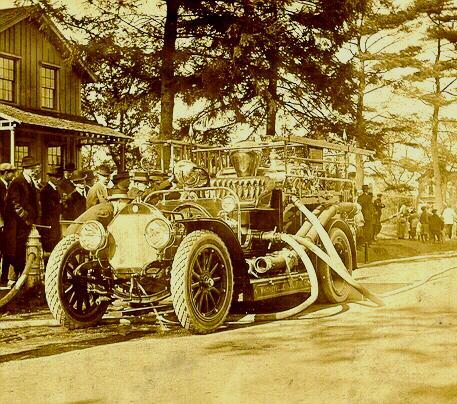 |
| Hamden's First - A 1915 Maxim |
|
|
|
This 1915 Maxim pumping engine on a Thomas Flyer chassis was Hamden's first motorized apparatus, purchased by Whitneyville Co. 3 in 1915.
This pumper also had the distinction of being the Maxim Company's first motorized pumping engine, as noted by author Walter McCall in his 1976 book, American Fire Engines Since 1900, Crestline Publications, Inc. (Glen Ellyn, IL: 1976).
|
 |
| MAY 1939 - 1935 Dodge 150 g.p.m. and 1919 Seagrave 350 g.p.m. pumper (Copy of original photo courtesy of Chan Brainard) |
|
|
Engine 7 (Mix District) - 1935 Dodge Bros. 150 g.p.m., purchased August 12, 1935 for $750. Utilized body of 1918 Stewart. Total cost: $1,267. Tank capacity 100 gal.
Engine 2 (Humphrey) - 1919 Seagrave 750 g.p.m., purchased June 1919 for $12.500. Transferred to Co. 1 on May 13, 1939 while Engine 1 was being repaired. (Job finished 1/25/1940) Balloon tires replaced the original solid rubber tires in 1925. Sent to Station 5 as a spare in 1942.
Humphrey's 1919 Seagrave and Whitneyville's 1915 Thomas-Flyer Maxim were Hamden's only right-hand drive apparatus. By 1916, almost all American-made automobiles were left-hand drive. But a few American fire apparatus manufacturers (most notably American LaFrance and Seagrave) continued to go with right-hand drive into the early 1930s, perhaps because it made spotting hydrants easier for the drivers. The smaller left-hand drive 1925 Seagrave Suburbanite was an exception because it was built on a different chassis from Seagraves' larger apparatus. (Also check out Co. 9's 1929 Seagrave tiller ladder truck on the Ladder Trucks page.)
From personal notes of Chief Charles Loller (courtesy of his great grandson, Russell Loller)
|
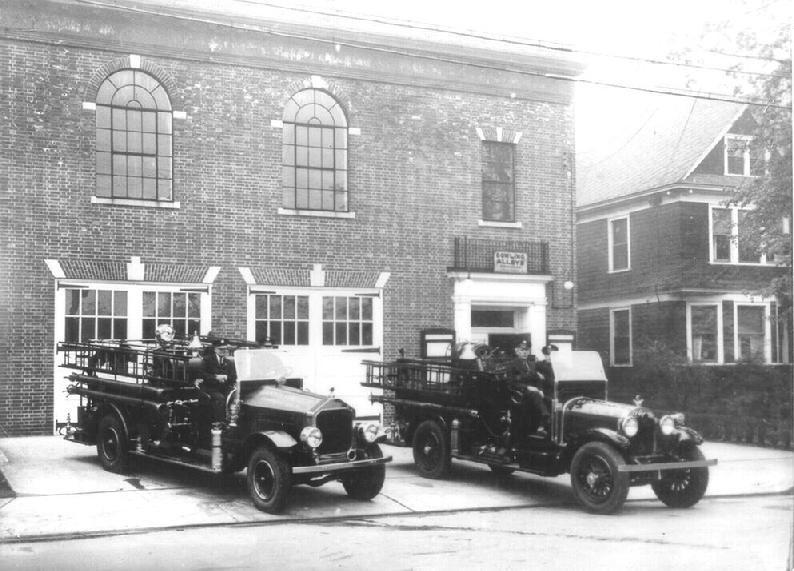 |
| MAY 1939 - 1930 Maxim 750 g.p.m. and 1924 Stutz 350 g.p.m. (Copy of original photo courtesy of Chan Brainard) |
|
|
Engine 5 (Mt. Carmel) - 1930 Maxim 750 g.p.m. rotary gear pumper, purchased January 6, 1930 for $8,500. It was transferred from Station 5 to Station 6 on August 6, 1952.
Engine 6 (Merritt Street) - 1924 Stutz 350 g.p.m., purchased April 1924 for $7,150. Tank capacity 70 gals. Weight: 11,000 lbs.
From personal notes of Chief Charles Loller (courtesy of his great grandson, Russell Loller)
|
 |
| MAY 1939 - 1926 Maxim City Service Ladder and 1926 Maxim 500 g.p.m. pumper (Copy of original photo courtesy of Chan Brainard) |
|
|
Hook & Ladder Co. 1 (Highwood) - 1926 Maxim City Service Ladder Truck. Weight: 10,100 lbs. Purchased March 23, 1926. Windshield installed 2/15/38. On March 19, 1941 at 4:31 p.m., this ladder truck was struck by a trolley car at the corner of Dixwell Avenue and Mather Street and was subsequently traded into the Wood Engineering Service of Topsfield, Massachusetts for a new city service ladder truck on a Diamond-T chassis.
Engine 1 (Highwood) - 1926 Maxim 500 g.p.m. rotary gear pumper. Purchased March 23, 1926. Traded in to the O.B. Maxwell Co. on January 18, 1954 for $900.00 toward purchase of a 1954 Maxim pumper.
Purchase price for both apparatus was $12,500.
From personal notes of Chief Charles Loller (courtesy of his great grandson, Russell Loller)
|
 |
| MAY 1939 - 1928 Maxim 600 g.p.m., 1925 Seagrave Suburbanite 150 g.p.m., and 1918 Stewart Chemical (Copy of original photo courtesy of Chan Brainard) |
|
|
|
Engine 3 (Whitneyville) - 1928 Maxim 600 g.p.m. rotary gear pumper, purchased February 1928 for $12,500. 70 gal. tank. Weight: 14,000 lbs. Traded in to the O.B. Maxwell Co. for $500.00 toward purchase of a 1952 Maxim pumper.
Spare - 1925 Seagrave Suburbanite 350 g.p.m., purchased May 7, 1925 for $6.500. Original tank capacity was 40 gal. Weight: 10,000 lbs. (Removed from service as Engine 4 in April 1938. This became Engine 8 on September 18, 1939 after it was sent to Boston to have the 350 g.p.m. pump removed and replaced with a 150 g.p.m. pump and a 200 gal. tank.) Traded in to the O.B. Maxwell Co. in 1959 for $250.00 toward purchase of the 1959 Maxim "cab-forward" pumper.
Engine 8 (Dunbar Hill) - 1918 Stewart (Originally Engine 5), purchased December 24, 1918 for $1,900. Tranferred to Co. 8 on August 18, 1930. Sold September 1939.
From personal notes of Chief Charles Loller (courtesy of his great grandson, Russell Loller)
|
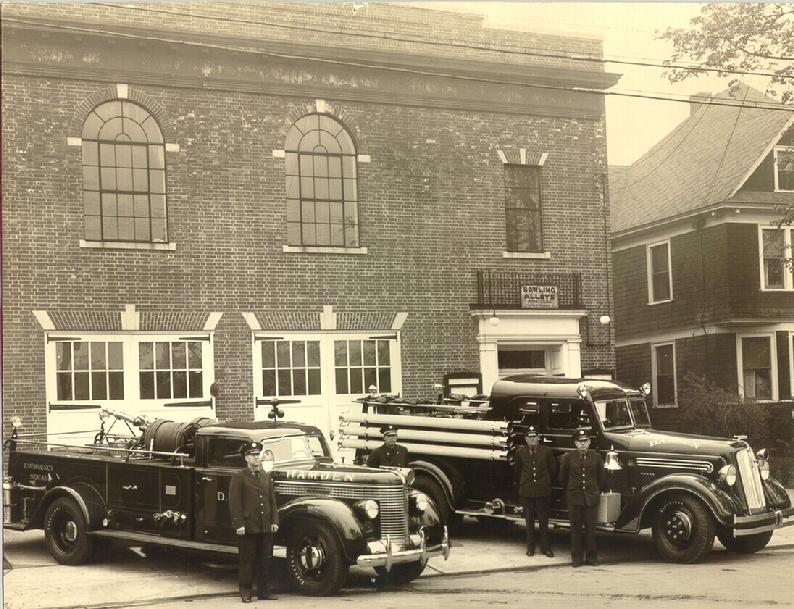 |
| MAY 1939 - 1938 Diamond-T Squad e/w 150 g.p.m. pump and 1938 Seagrave Canopy Cab 600 g.p.m. |
|
|
Emergency Squad - 1938 Diamond-T e/w 150 g.p.m. pump and deluge set. Placed in service at Station 4 at 6 p.m. on February 26, 1938. Cost $1,976. Weight: 10,500 lbs. Sold at auction in November 1971 for $272.00.
Engine 4 - 1938 Seagrave Canopy Cab 600 g.p.m. pumper. 100 gal. tank. Placed in service at Station 4 as Engine 4 on April 12, 1938. Cost: $7.524. Transferred to Co. 2 on June 13, 1939. Weight: 13,000 lbs.
From personal notes of Chief Charles Loller (courtesy of his great grandson, Russell Loller)
|
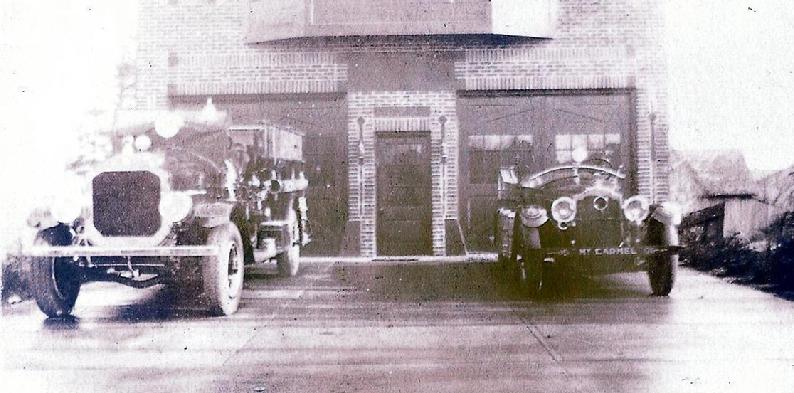 |
| c. 1929 - Mt. Carmel Station 5 - 1928 Maxim 600 g.p.m. rotary gear pumper and 1921 Packard Twin-6 Chemical Truck (Photo courtesy of Gilbert Spencer) |
|
|
|
Pictured on the front ramp at Station 5 in Mt. Carmel are a 1928 Maxim 600 g.p.m. rotary gear pumper and a 1921 Packard Twin-6 chemical wagon. The Mt. Carmel Volunteer Fire Co. was organized on November 8, 1911. The company built the fire station in 1925.
Starting with only one paid driver back then, career personnel have been stationed at the Mt. Carmel station ever since. The first paid driver for Co. 5 was Al Purce, who became the Department's first fulltime Fire Marshal in 1943. Previously, the duties of fire marshal fell to the First Selectman.
|
 |
| 1940 Photo - 1939 Diamond-T 600 g.p.m. pumper from Wood Engineering Service of Topsfield, Massachusetts |
|
|
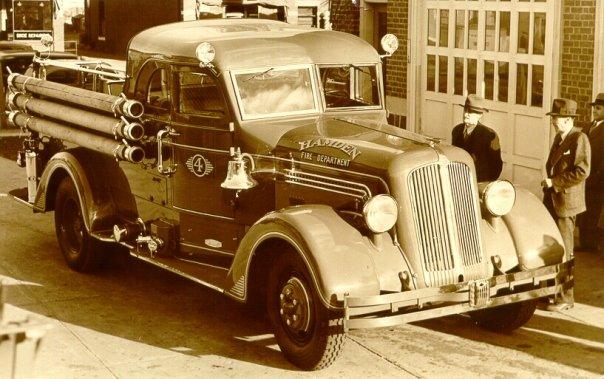 |
| 1938 Seagrave Canopy Cab 600 g.p.m. |
|
|
1938 Seagrave Canopy Cab 600 g.p.m. pumper after delivery. Apparently this engine was a "floor model" that was already painted the bright "Seagrave Red" when it was purchased. Shortly thereafter, it was repainted the darker red used on Hamden apparatus. This picture was taken in front of the north-facing bay doors of the Town Hall fire station (Station 4) before the bay doors were relocated to face Whitney Avenue on the east side of the building during 1939-40.
|
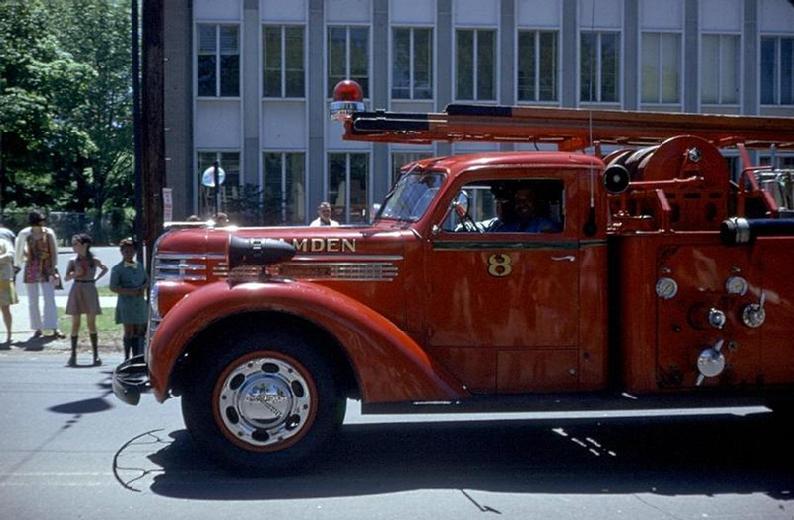 |
| Memorial Day 1970 - Co. 8's 1942 Diamond-T 500 g.p.m. pumper (Photo by Ed Doiron) |
|
|
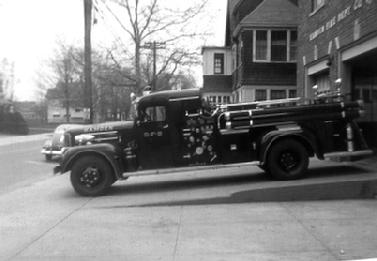 |
| 1951 Maxim 750 g.p.m. |
|
|
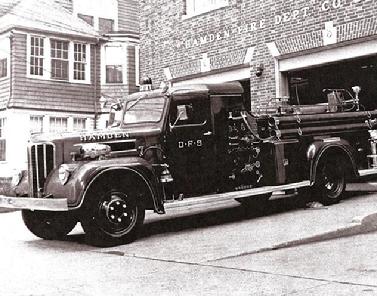 |
| 1951 Maxim 750 g.p.m. (Copy of original photo courtesy of Chan Brainard) |
|
|
|
1951 Maxim 750 g.p.m. pumper - Delivered August 7, 1951, this was the first Maxim apparatus purchased by Hamden since 1930. Nine more Maxims would follow in the next 23 years. The above two photos were taken after this piece was transferred to Station 3 on August 4, 1952.
|
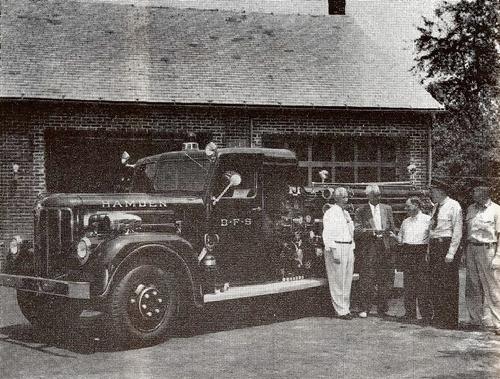 |
| 1952 Maxim 750 g.p.m. pumper - July 28, 1952 - Hamden's second postwar Maxim pumper is received at the Repair Shop behind Station 2. The Board of Fire Commissioners are pictured here with Chief Raymond C. Spencer (2nd from right) and Supt. Clem Wetmore (far right). |
|
|
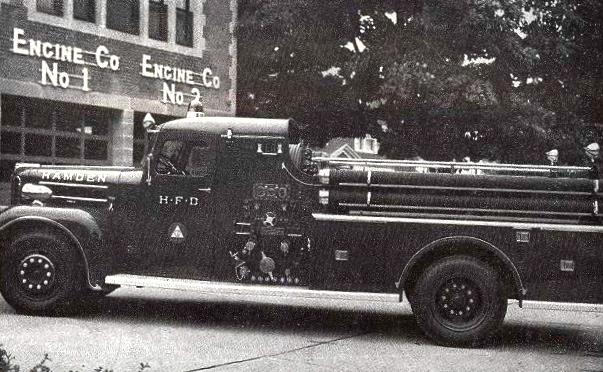 |
| 1954 Maxim 750 g.p.m. pumper - Was placed in service at Headquarters on October 3, 1954. Half of the $16, 968 cost of this pumper was paid by Civil Defense, hence the "CD" logo on the door. Unlike the previous two Maxim pumpers, the 1954 had flat side compartments. This engine was still in service as a volunteer piece well into the 1980s. |
|
|
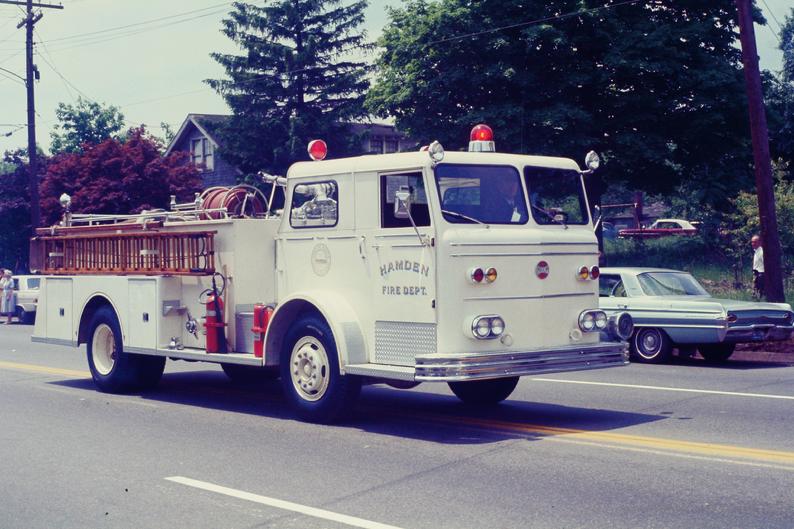 |
| MEMORIAL DAY 1966 - 1959 Maxim 750 g.p.m. "Cab-Forward" (Photo by Ed Doiron) |
|
|
In 1915, the Whitneyville Vol. Fire Co. No. 3 purchased Maxim's first motorized pumping engine. Forty-four years later, the Hamden Fire Department purchased Maxim's first "cab-forward" pumper, a Model F-2617-C 750 g.p.m. pumping engine, for $19,135.
This pumper was delivered painted white on June 29, 1959 and was Engine 2 for most of its active days. In 1971, it was repainted "Maxim red" along with the 1958 junior aerial truck. In 1974, it was reassigned to Station 3 as Engine 6, which had become the designation for the Department's spare. In 1981, it was repowered with a diesel engine. And on January 24, 1995, the 1959 Maxim "cab-forward" was retired from service.
Starting with the 1958 Maxim 75' "Junior" aerial ladder and the 1958 International Travel-al rescue, the Board of Fire Commissioners began ordering Hamden's apparatus in white - just like its neighbor to the south. But after the subsequent purchases of another white International Travel-al rescue and a few more white staff vehicles, Hamden went back to red apparatus with the purchase of the 1965 Mack 750 g.p.m. pumper. Ever since the 1984 purchase of two identical Pierce pumpers, Hamden pumpers and trucks have sported red bodies with white roofs.
|
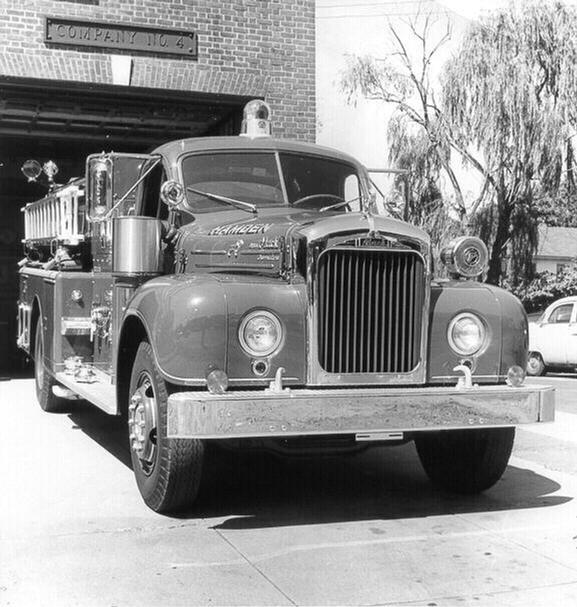 |
| 1965 Mack 750 g.p.m. |
|
|
|
1965 Mack 750 g.p.m. pumper, the first new apparatus after HFD went back to red. It was first placed in service on August 18, 1965 as a temporary replacement while Engine 2 was being repaired.
The '65 Mack was the first new full-size apparatus on a commercial chassis since the Diamond-Ts that were purchased before World War II, and it is the last to date. The '65 Mack served as Engine 4, Engine 2, Engine 5, Engine 9 and Engine 7 before being retired in the early 2000s.
|
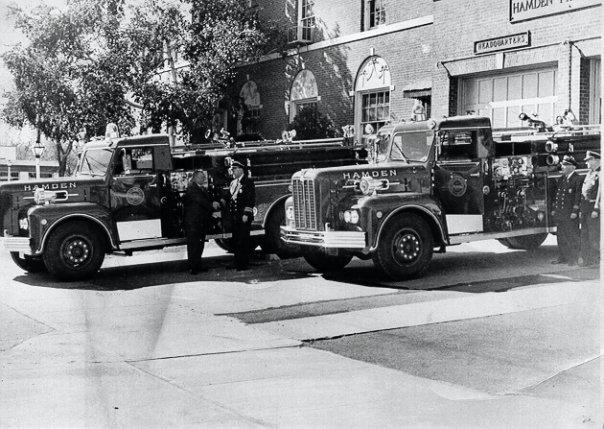 |
| November 1968 - Two new Maxim S-model 1000 g.p.m. pumpers |
|
|
Mayor William Adams presents two 1968 Maxim Model-S 1000 g.p.m. pumpers to Chief V. Paul Leddy, while Dep. Chief Training Officer Daniel Hume and Supt. of Alarms and Apparatus Clem Wetmore look on.
|
 |
| 1974 - Two new Maxim pumpers |
|
|
|
Chief V. Paul Leddy and Mayor Lucien DiMeo pose in front of Station 4 with two new Maxim pumpers, delivered in early 1974. Although these pumpers arrived in 1974, delivery documents indicate that they were 1973 models. These would be the last of ten postwar purchases from Maxim.
In the foreground is Engine 4, a Maxim 1000 GPM pumper (Chassis Model FFC 7510-C) powered with a 320 h.p. Cummins diesel engine. It was equipped with a foam delivery system consisting of an onboard foam bladder that was suspended inside the tank, a cab-mounted turret nozzle that could be operated from inside the cab, and a pair of ground sweeps mounted beneath the front bumper. This pumper was specially equipped so that it could pump and roll at the same time. It was placed in service at Station 4 on February 7, 1974.
In the background is Engine 3, a Maxim 1000 GPM "Telesqurt" (Chassis Model FFC 7510-C) powered with a 320 h.p. Cummins diesel engine. The telesqurt was operated from the rear step. It was placed in service at Station 3 on April 1, 1974.
Engine 4 was originally intended to be Engine 3 because of Station 3's proximity to the tank farm on Welton Street. The Telesqurt was originally intended to be Engine 4, but it would not fit inside Station 4, and had to be housed at Station 3.
After two new 1000 g.p.m. Pierce "Dash" pumpers were delivered in December 1984, the Pierce Co. of Appleton, Wisconsin rebuilt both of these pumpers. Each received a new body with high-side compartments, and a new two-tone paint job. The "Telesqurt" returned to service as Engine 3. The foam delivery system on Engine 4 was removed and it went back in service as Engine 9. Both pieces remained in service until the late 1990s. Just why the front bumper is missing from the "new" Engine 9 in the 1985 photo (below on the right) is a mystery.
|
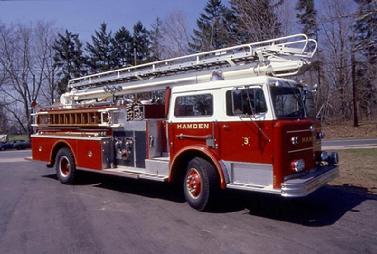 |
| 1973 Telesqurt rebuilt and back as Engine 3. The new high-side compartments are on the driver's side. |
|
|
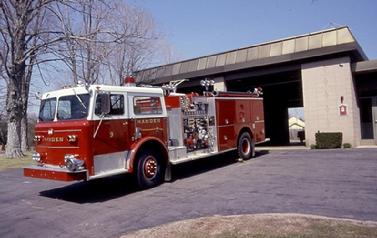 |
| Old Engine 4 rebuilt and back in service as Engine 9 |
|
|
 |
| 1978 Pierce Mini-Pumper on Ford F350 Chassis - 250 g.p.m. pump (Photo by Ed Doiron) |
|
|
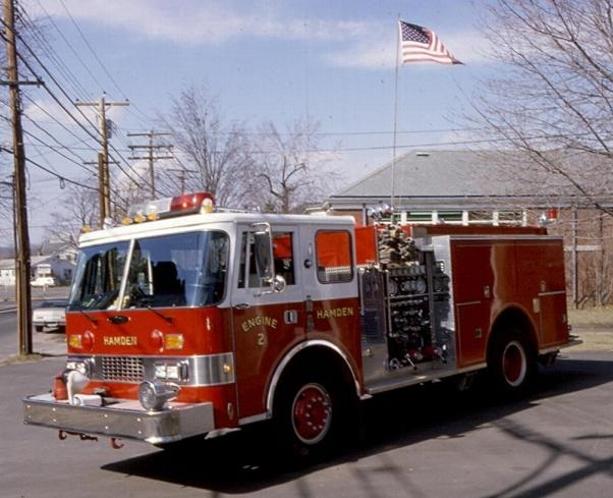 |
| March 1985 - 1984 Pierce "Dash" 1000 g.p.m. pumper on the ramp at Station 2. One of two identical pumpers delivered in December 1984. The other 1984 Pierce "Dash" was assigned as Engine 4. |
|
|
All photos on this website not otherwise in the Public Domain, as well as all commentary,
are © Copyright 2009 by the Hamden Fire Retirees' Assn.
|
|